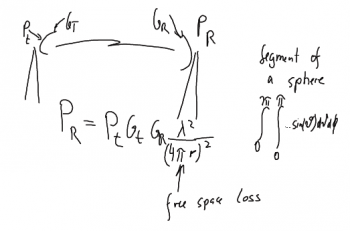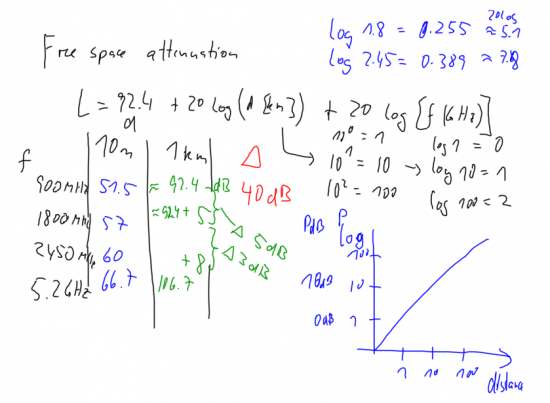Difference between revisions of "B1-Free Space Propagation"
From its-wiki.no
Josef.Noll (Talk | contribs) (Created page with "B1") |
Josef.Noll (Talk | contribs) |
||
| Line 1: | Line 1: | ||
| − | + | ==⌘ Free space propagation == | |
| + | <span style="color:#000B80"> develop propagation equation</span>, see (http://www.antenna-theory.com/basics/friis.php) | ||
| + | |||
| + | <math>P_r = P_t \ G_t\ G_r\ \left (\frac{\lambda}{4\pi r} \right )^2\cdot </math> | ||
| + | |||
| + | * <span style="color:#000B80"> convert into dB </span> | ||
| + | * <span style="color:#000B80"> provide examples for f = 10 MHz, 1 GHz, 100 GHz</span> | ||
| + | * <span style="color:#000B80"> discuss influences on radiation pattern</span> | ||
| + | |||
| + | Free space attenuation | ||
| + | <math>L = 92,4 + 20 \log(d \mathrm{[km]}) + 20 \log(f \mathrm{[/GHz]}) </math> | ||
| + | |||
| + | ===⌘Comments === | ||
| + | {| | ||
| + | |[[File:f3-11.png|350px]] | ||
| + | |Free space propagation from a transmit (''t'') to a receive (''r'') station. | ||
| + | |} | ||
| + | |||
| + | [[File:FreeSpaceAttenuation.png|550px]] | ||
| + | |||
| + | Calculation of free space attenuation. Note the increased free-space attenuation of approx 5 dB from 900 to 1800 Unik/MHz, and a further increase of 3 dB from 1800 (GSM 1800) to 2450 Unik/MHz (802.11b). Note also that increasing the distance by a factor of 10 will increase the power requirements by 20 dB. | ||
Revision as of 20:47, 20 September 2014
| Wiki for ITS | ||||||
|---|---|---|---|---|---|---|
|
⌘ Free space propagation
develop propagation equation, see (http://www.antenna-theory.com/basics/friis.php)
- convert into dB
- provide examples for f = 10 MHz, 1 GHz, 100 GHz
- discuss influences on radiation pattern
Free space attenuation
⌘Comments

|
Free space propagation from a transmit (t) to a receive (r) station. |
Calculation of free space attenuation. Note the increased free-space attenuation of approx 5 dB from 900 to 1800 Unik/MHz, and a further increase of 3 dB from 1800 (GSM 1800) to 2450 Unik/MHz (802.11b). Note also that increasing the distance by a factor of 10 will increase the power requirements by 20 dB.
